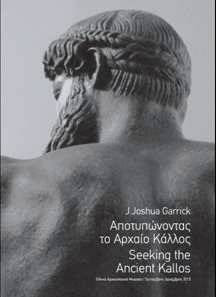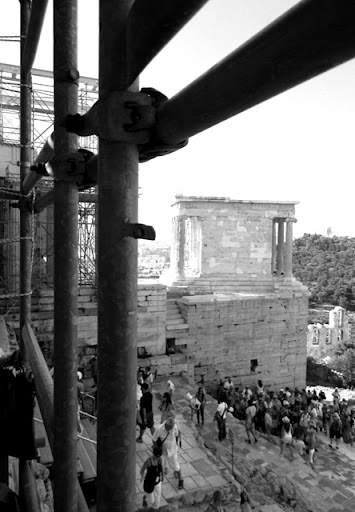American Photographer Makes Art History in Prestigious Greek Museum
One of our very own - longtime friend and Florida Arts Editor Josh Garrick – makes art history in Greece. It’s the story of an artist, of a love of place, and a lifetime of respect for history, culture, and the incredible art in Greece. He’s the first American to EVER exhibit at the National Archaeological Museum of Greece, in Athens (one of the top 10 Museums in the world!). He’ll be there, this fall, for this ground-breaking exhibit – and has generously offered to talk with visiting scholars and study abroad students on the Art and Culture of Ancient Greece (details below).

Death Foretold
We had a chance to catch up with Josh, and learn more about art history in the making, how he works, how his prints are created on such a large scale, and more. Here’s what he had to say…
Please tell us about your new, history-making exhibit at the National Museum of Archaeology in Athens, Greece...
The most incredible thing for me is to have both the honor and the responsibility of being the FIRST American in the 124-year history of the National Archaeological Museum of Greece to exhibit my Art in that most prestigious Museum. My passion for Ancient Greece (most people simply call it an obsession) has been with me since childhood. The exhibit, Seeking the Ancient Kallos, will be shown Sept. 12, 2013 through Jan. 8, 2014 with most of the works highlighting details of the Greek treasures that may be found within the Museum. The National Archaeological Museum ranks among the top 10 museums of the world, and they are going to exhibit my black and white photography – printed on aluminum – for four months. Every time I say it, I get goosebumps and need someone to pinch me to assure me it’s real.

National Archaeological Museum catalog cover

Beauty That Never Fades
What events led to this exhibit?
Anything of this magnitude has a series of events coming together to make it happen. You could say it began 30 years ago, when I first met my friend Marios Voutsinas. We were both young Artists, and our friendship has grown into a relationship in which we honestly see each other as “brothers.” Marios is not only my best friend in Greece; he’s my best friend in the world, and over the years he’s helped me gain access to many Greek monuments, museums, and works of art that most ‘foreigners’ don’t have. The thing is – I never feel like a foreigner in Greece. From my very first trip – fresh out of grad school – I’ve always felt like I am “home” when I’m there. I’ve been back more than 40 times, including the times I’ve traveled to Greece as a professor with students from the School of Visual Arts in New York City.
The specific event that led to the exhibit was the gift of a small work I had done – on aluminum – and given to Marios as a gift. He’s fortunate to work with – and have a friendship with - Iris Kritikou. Iris is the finest, most knowledgeable curator I’ve ever met, and when she saw the work, I’m honored to say she liked it … She really liked it. Iris and Marios developed a plan to have the work seen by Dr. George Kakavas, the Director of the National Archaeological Museum – and I swear I knew nothing about the plan. Dr. Kakavas liked what he saw – it led to the initial interviews, and I promise I will never forget the moment when Dr. Kakavas turned to me and said, “Could you be ready for an Opening on September 12th?” I had stopped breathing, and I’m sure I looked – shall we say – less than intelligent when I gulped for air just so I could say “Yes.”
What got you interested in learning about - and photographing - Greece?
Jessie – there is no clear answer to that. I admit it’s an obsession, and it’s always been with me. Growing up in farm country in Pennsylvania – far from large cities which celebrate the ARTS in their museums and concert halls – my unexplained love of all things having to do with ancient Greece seemed to me (as a student) to be as unattainable as the adventures of the Star Wars sagas. But my obsession with Greece, that compelling desire to walk where Socrates and Pericles and Phidias walked, was ALWAYS inside me. If there existed a way for us mortals to question Zeus, perhaps HE could explain why I was chosen to help spread the word of the wonders of Greece. I gave up questioning WHY and have spent my adult life sharing my love and respect for that time – 2400 years ago – when the greatest collection of geniuses the world has ever known walked the streets of Athens.
My earliest work, thanks to a graduation gift that became my first trip to Greece, was based on photo-journalism.But once I got there, I immediately realized I had never seen the color blue as brilliant as the blue of the sky in Greece, I had never experienced swimming in water so magnificently clean and clear that “seeing the bottom” was taken for granted, and I had never experienced the majesty of eagles flying over Mt. Parnassus in Delphi immediately following a thunderstorm. That happened as I arrived in Delphi for the first time, and I saw those eagles and thunderbolts as a message from Zeus himself. I was finally in Greece … and I was HOME. I can say with absolute certainty – the awesome beauty of Greece turned me into a fine art photographer.

Zeus in the Museum

Bocephalus
You'll be in residence in Athens this fall - any events we should know about?
The Opening is on September 12, and I know there will be lectures – some in Greek – some in English, but the actual dates and times have not been set. I will be checking my emails daily and invite anyone traveling to Greece to write to me at josh [at] joshgarrick.com. As time goes by, I’ll have a better handle on what events will be happening – and when.

Leap of Faith (taken while standing on the roof of the Parthenon -- example of access granted to J. Garrick -- NOT given to any other 'foreign' photographer)
You're available to speak with study abroad students and faculty in Greece this fall - on which topics? How can wandering educators reach you, to schedule something?
I’ve mentioned that I led and taught 15 student groups to Greece for the School of Visual Arts. Each trip was a 3-week Humanities course with the course title, “The Art & Culture of Ancient Greece,” and each of those trips BEGAN at the National Archaeological Museum in Athens. The Museum is filled with some of the greatest works of Art ever created. Based on timing and permissions, it would be my pleasure to share some of those insights with other “wandering educators” and students. At this time, the best way to communicate with me would be my email address listed above.

On the Scaffolding
Can you please share with us your process for printing on aluminum?
Thanks to evolving technology, it’s a mix of ‘traditional’ photo reproduction and the most up-to-date advertising signage. Suffice it to say, the works require carefully formulated inks on a huge press. One of the most fortunate things for me is the fact that the gentleman who directs Jai Gallery, the Gallery where my work is shown in the United States, is also one of the “creators” who has helped create and refine the process. His name is Dennis Liddy, and I’m forever grateful for the time and care that he and others have spent experimenting with the images. Because the Museum in Athens is so large, there will be more of the ‘monumental’ images – one photograph will be more than 8 feet tall – in this exhibit. Seeing them produced – seeing them in a size I could only imagine before – is an incredible feeling.

Tribute to Archimedes
Any words of advice for young photography students?
I’ve always taught my students, ‘the responsibility of the photographer is to help the viewer see in a different way.’ Out of respect for the Artists who created these works thousands of years ago, I feel an enormous responsibility to honor the brilliance and sense of pride in humanity that these works represent. I want to see students combine photography's representative nature with its expressive potential. I want them to open their minds to the unique dignity and inner lives of the statues and monuments. Over decades, I’ve developed my own ‘ability to see’ by focusing on details of statues and buildings, as for example, the hand of a statue or a single pillar from a temple. These details have become my own form of ‘abstraction’ and led to a series of pictures which bring the viewer ever closer to the image – inviting them to ‘see the works in a different way.’ I’m honored that the curator – Iris Kritikou – has stated that there are certain angles with which I photograph a white marble statue in a way that shows this statue was once a living, breathing person. That is the essence of what I try to do with the camera.

The Calf Bearer
Any final thoughts …
It is my sincere hope that my photographs help persuade those who view my work to recognize – and value – the cultural legacy that began in Athens. It is the greatest honor of my life to bring my work ‘home to Greece.’ Recognizing that these statues and monuments are Greece’s priceless gift to the world, I humbly submit my photographs to the City of Athens in the year 2013 A.D. As I do, I ask each of us to reflect and understand how very different our lives would be today if Athens had not been “the school to the world” over 2400 years ago.




















